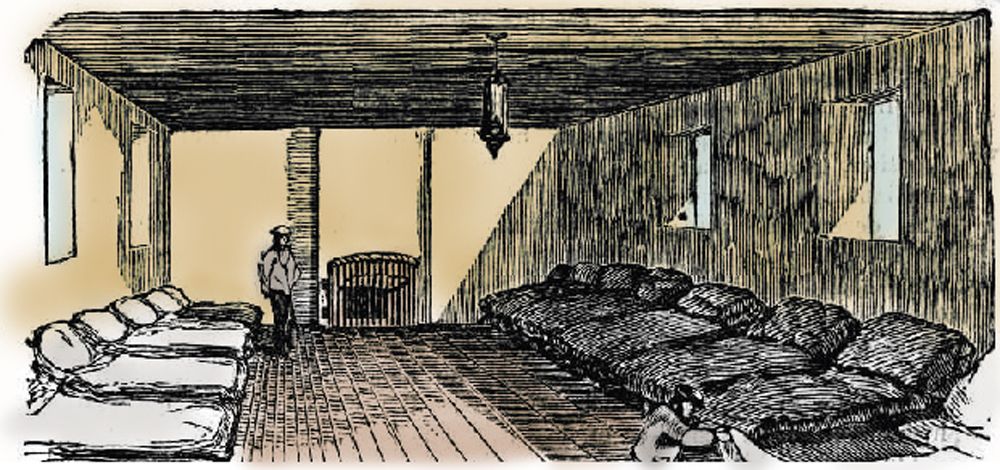
Parramatta Lunatic Asylum Dormitory, June 1861
Since the first transfer of patients in 1846, the site has remained home to psychiatric and mental health for Western Sydney, although it has undergone several name changes. These name changes also reflect changing attitudes towards mental health over the last 150 years. Up to 1878, it was known as the Parramatta Lunatic Asylum. From 1878 to 1916, it became the Parramatta Hospital for the Insane. Between 1916 and 1962, it was referred to as the Parramatta Mental Hospital, while from 1962 to 1983 it was the Parramatta Psychiatric Centre. From 1983 up to the present, it is known as the Cumberland Hospital.
From the outset, Parramatta Lunatic Asylum consisted of a free, and a criminally insane division, with separate registers kept for persons admitted into each. On 31 December 1873 Parramatta Lunatic Asylum contained 704 free patients, 45 criminal patients (confined under the provisions of the Criminal Lunacy Act 1860), and 36 convict patients (accommodated within the free division, but as British convicts maintained at the charge of the Imperial Treasury).
On 28 December 1849, a notice was published, stating that a portion of the Invalid Establishment at Parramatta had been appointed a public asylum for the reception and custody of lunatics. The Convict, Lunatic, and Invalid Establishment had replaced the Female Factory when it closed at the end of 1847, leaving only invalid or insane inmates still resident. Personnel were appointed to staff the institution on 1 April 1848, and although separate personnel lists were published for the Convict, Lunatic, and Invalid Establishment, and for the Lunatic Asylum, Parramatta from 1850, the same senior administrative and medical staff were listed as appointed to identical positions in both institutions. In personnel lists for 1856 a list for Lunatic Asylums, Parramatta appears but the Convict, Lunatic, and Invalid Establishment is no longer listed as a separate institution. From the outset, Parramatta Lunatic Asylum consisted of a free, and a criminally insane division, with separate registers kept for persons admitted into each. On 31 December 1873 Parramatta Lunatic Asylum contained 704 free patients, 45 criminal patients (confined under the provisions of the Criminal Lunacy Act 1860), and 36 convict patients (accommodated within the free division, but as British convicts maintained at the charge of the Imperial Treasury).
By the mid-1850s the former Female Factory buildings were occupied by lunatics and aged and infirm invalids. The classification and separation of spaces within the main Female Factory building remained, with the aged and infirm invalids of both sexes occupying the southern side (former 2nd class convict spaces) and the male lunatics occupying the northern side (or 1st class areas). The female lunatics were also housed in the old three-storey Cell Block built by Governor Gipps. This remained the principal accommodation for female lunatics until 1883.
In 1868 Dr Frederick Norton Manning described Parramatta Lunatic Asylum as unfit as a residence for those mentally afflicted, with it’s “gloomy and ill-ventilated cells and their iron-barred doors.” Although a new storey and separate cells had been added to the criminal division building, by 1868 this was full, and overcrowding of the free division remained unallieviated. In June 1885 a new hospital building was completed, and the old central Female Factory building, described as an “unsightly and ruinous pile” was demolished.
Neera Sahni, Research Services Leader, Parramatta Heritage Centre, City of Parramatta, 2020
Refrences:
- http://heritagensw.intersearch.com.au/heritagenswjspui/handle/1/9803
- http://www.caseyandlowe.com.au/portfolio_page/parramatta-north-projects/
- http://arc.parracity.nsw.gov.au/blog/2015/08/12/history-of-the-parramatta-lunatic-asylum-1848-1878/
- https://trove.nla.gov.au/newspaper/article/72486402, Retrieved on 5 June 2020.
- Tucker, G.A., Lunacy in Many Lands: A report to the Government of New South Wales, Government Printer, Sydney, 1887, p.650
- Hospital for the Insane Tarban Creek, Report dated 22 October 1868, in Votes and Proceedings 1869, Vol 2, p.633
- Inspector General of the Insane, Report for the year ended 31 December 1885, in Votes and Proceedings 1885-86, Vol 2, p.508
- Log in to post comments


